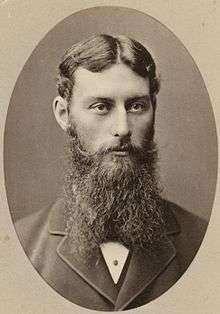David Lindsay (explorer)

David Lindsay (20 June 1856 – 17 December 1922) was an Australian explorer and surveyor and a fellow of the Royal Geographical Society, London.[1]
Early life
Lindsay was born in Goolwa, South Australia, a son of Captain John Scott Lindsay (ca.1819 – 29 June 1878), master mariner formerly of Dundee, Scotland, and his wife Catherine, née Reid (ca.1822 – 28 May 1884). John Lindsay commanded the brig Europa and Sir James Fergusson's yacht Edith[2] before a career on Murray River steamers which included a pioneering trip to Brewarrina with W. R. Randell in 1859. Young Lindsay was educated in Goolwa and under Rev. John Hotham at Port Elliot. At age 15 Lindsay went to work in a chemist shop and then with an Adelaide mining agent.[1]
Explorer
Lindsay became an apprentice in the state government survey department in 1873. In 1878 he was appointed ("gazetted" in Public Service parlance) as a senior surveyor in March 1875. In 1878 he was appointed junior surveyor and clerk in the land office of the Department of the Northern Territory at Palmerston (now Darwin) in the Northern Territory. In 1882 he resigned from the government service to take up private practice, but about a year later was placed in charge of a South Australian government expedition to Arnhem Land (in the Northern Territory).[1] The party, consisting of four white men and two Indigenous Australians, met with a hostile response from local Aboriginal people, and drove them off with firearms. Some of the horses had been stampeded during the conflict and the explorers only reached civilisation after suffering many privations. Lindsay subsequently explored territory between the Overland Telegraph Line and the Queensland border and discovered Australia's first payable mica field.[3] In 1886 Lindsay was exploring in the region of the MacDonnell Ranges and discovered so-called rubies.[4] The 1885–86 expedition traced the Finke River to its mouth.[1]
Early in 1891 Lindsay was placed in charge of the Elder Scientific Exploring Expedition entirely equipped by Sir Thomas Elder, and which included Dr. Elliott, a Queensland medical man with photographic and botanical expertise; Helms of the Sydney Museum and Streich, a German geologist and mineralogist.[5] Starting from Warrina, South Australia, with 42 camels[1] on 2 May 1891 with the intention of covering as much unexplored territory as possible between there and the western coast of Australia, the expedition was unfortunate in striking an extremely dry season, the results were disappointing, and the expedition was abandoned without completing much that had been intended. However, in the 11 months to 4 April 1892 over 4000 miles (6,400 km) were traversed, and about 80,000 square miles (206,000 km²). were mapped. Charges were made by the second officer and three other members of the party concerning Lindsay's management of the expedition, but after an inquiry had been held he was exonerated. The abandonment of the expedition was 'a terrible disappointment' to Lindsay.[1]
In 1893, Lindsay overlanded camels to Coolgardie after news of gold discoveries there, and sold them at a profit.[1]
Later life

In 1895 Lindsay was in business as a stockbroker, formed various companies in connexion with Western Australian goldmines, and not long before World War I broke out in 1914 was in London raising capital for development work in the Northern Territory. This work and other projects had to be abandoned on account of the war.
After the war, Lindsay was in the Northern Territory for three and a half years carrying out topographical surveys for the Australian Federal government. Some good pastoral land was discovered, and Lindsay satisfied himself that the Queensland artesian water system extended some 150 miles farther west than its supposed limits. He was working in the north again in 1922 but was attacked by illness and died in the Darwin hospital of valvular disease of the heart on 17 December 1922.[1] Lindsay had married Annie Theresa Stuart Lindsay (no relation) on 10 March 1881 who survived him with four sons and a daughter. Lindsay was tall and broad-shouldered of a genial disposition, a typical and capable bushman.[1]
References
- 1 2 3 4 5 6 7 8 9 Suzanne Edgar, 'Lindsay, David (1856–1922)', Australian Dictionary of Biography, Volume 10, Melbourne University Press, 1986, pp 105–106. Retrieved 14 September 2009
- ↑ "Death of Captain Lindsay". South Australian Register. Adelaide: National Library of Australia. 1 July 1878. p. 4. Retrieved 1 November 2013.
- ↑ "Australian Exploration". South Australian Register. Adelaide: National Library of Australia. 31 March 1891. p. 2. Retrieved 1 November 2013.
- ↑
- Serle, Percival (1949). "Lindsay, David". Dictionary of Australian Biography. Sydney: Angus and Robertson. Retrieved 14 September 2009.
- ↑ "Some Particulars of the Party". South Australian Register. Adelaide: National Library of Australia. 26 March 1891. p. 6. Retrieved 1 November 2013.
- Kimberly, W.B. (compiler) (1897). History of West Australia. A Narrative of her Past. Together With Biographies of Her Leading Men. Melbourne: F.W. Niven.